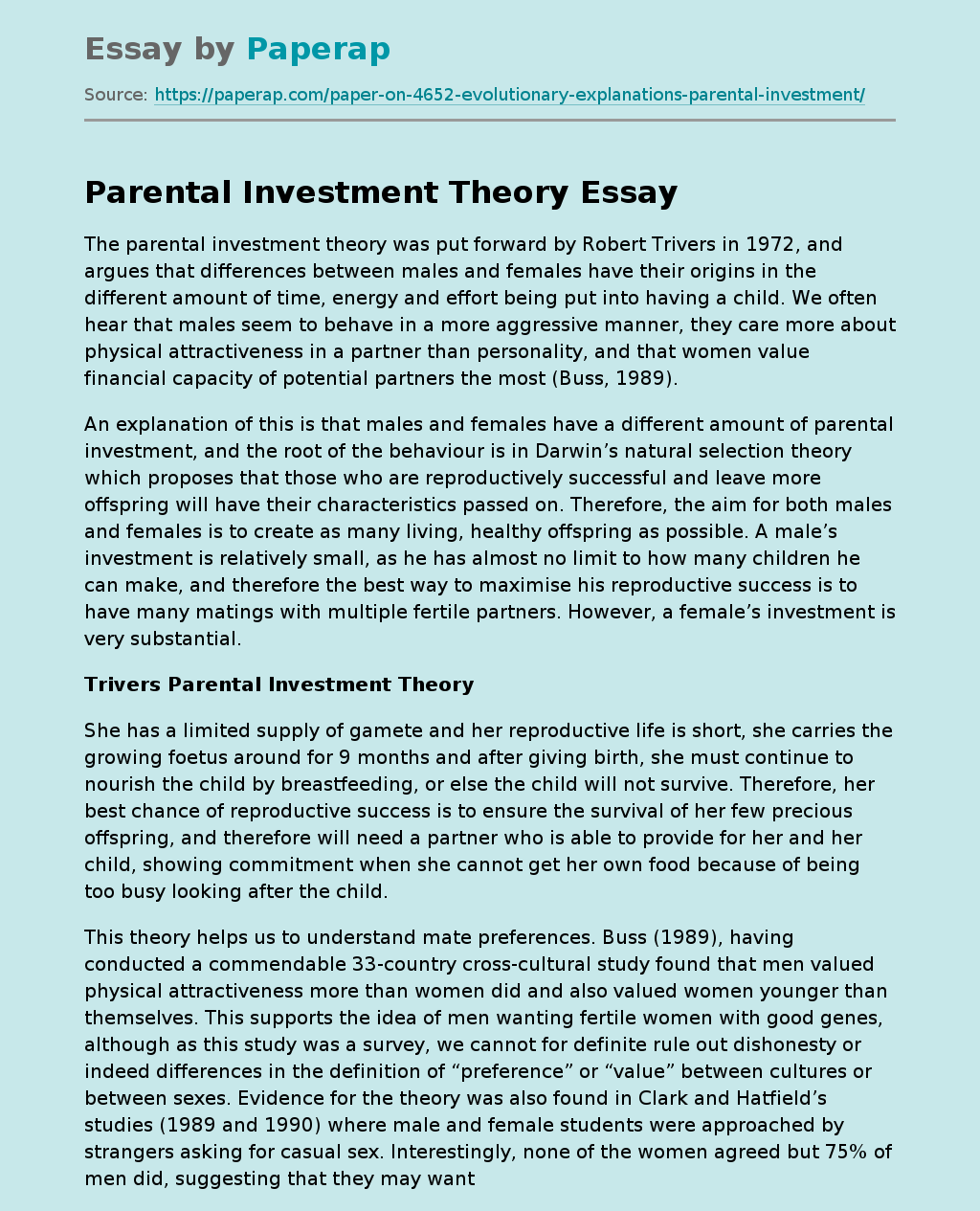Parental Investment Theory
The parental investment theory was put forward by Robert Trivers in 1972, and argues that differences between males and females have their origins in the different amount of time, energy and effort being put into having a child. We often hear that males seem to behave in a more aggressive manner, they care more about physical attractiveness in a partner than personality, and that women value financial capacity of potential partners the most (Buss, 1989).
An explanation of this is that males and females have a different amount of parental investment, and the root of the behaviour is in Darwin’s natural selection theory which proposes that those who are reproductively successful and leave more offspring will have their characteristics passed on.
Therefore, the aim for both males and females is to create as many living, healthy offspring as possible. A male’s investment is relatively small, as he has almost no limit to how many children he can make, and therefore the best way to maximise his reproductive success is to have many matings with multiple fertile partners.
However, a female’s investment is very substantial.
Trivers Parental Investment Theory
She has a limited supply of gamete and her reproductive life is short, she carries the growing foetus around for 9 months and after giving birth, she must continue to nourish the child by breastfeeding, or else the child will not survive. Therefore, her best chance of reproductive success is to ensure the survival of her few precious offspring, and therefore will need a partner who is able to provide for her and her child, showing commitment when she cannot get her own food because of being too busy looking after the child.
This theory helps us to understand mate preferences. Buss (1989), having conducted a commendable 33-country cross-cultural study found that men valued physical attractiveness more than women did and also valued women younger than themselves. This supports the idea of men wanting fertile women with good genes, although as this study was a survey, we cannot for definite rule out dishonesty or indeed differences in the definition of “preference” or “value” between cultures or between sexes. Evidence for the theory was also found in Clark and Hatfield’s studies (1989 and 1990) where male and female students were approached by strangers asking for casual sex. Interestingly, none of the women agreed but 75% of men did, suggesting that they may want to spread out their genes between willing fertile volunteers.
Trivers’ theory helps us to understand the observed differences in sexual jealousy (men became more distressed at the thought of their partners being sexually unfaithful whilst women were more concerned with their male partner being in love with another person – Buss, 1993). It must be mentioned here that this type of experiment has several ethical problems, like the lack of informed consent at the beginning and distress. It may just have been that the females felt more vulnerable since they did not know the strangers and perhaps would have agreed under different circumstances. Also, the outcome of the study may have been down to biological differences in hormone levels and brain structure rather than evolutionary behaviour.
The parental investment theory suggests that a male is more likely to want lots of partners for reproductive success, and evidence for this was given by Buss and Schmitt (1993) when they asked men and women their ideal number of sexual partners in a lifetime. The averages were, respectively, 18 (men) and between 4 and 5 (women). This clear difference shows that men tend to seek and desire a greater number of partners, and the theory can explain why this is. A major flaw in the evolutionary explanation is that it is practically impossible to prove it because we cannot, as of yet, travel through time and witness the behaviour of our predecessors firsthand. Having said this, it is relatively reliable due to its links with Darwin’s widely-accepted theories of sexual selection and natural selection.
Furthermore, the theory ignores the obvious evidence that not all mating is about long-term relationships and that women as well as men clearly engage in short-term relationships. An extension or even improvement of the theory is the Sexual Strategies theory devised by Buss and Schmitt (1993). It argues that the parental investment theory is too reductionist and that men and women might look for both a short-term and long-term mate, and demonstrates behaviours for both; women as well as men might want to have a one-night stand for mate insurance, just in case her proper mate disappears. There has been evidence to support this (Norman and Kendrick, 2006), showing that women will look for physically attractive males especially in a one-night stand.
It would seem that the parental investment theory may be rather accurate in that it explains a variety of behaviour differences between males and females, but it is almost impossible to prove and other theories such as the SS theory by Buss and Schmitt (1993) provides an answer to some of the limitations of the theory. It is likely that the two theories together provide a better explanation than the parental investment theory alone.
Parental Investment Theory. (2019, Dec 05). Retrieved from https://paperap.com/paper-on-4652-evolutionary-explanations-parental-investment/

